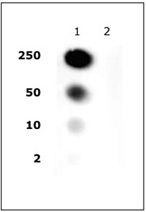Histone H2A/H4S1ph antibody (pAb)
Host / Isotype
Rabbit / Serum
Reactivity
Human, Wide Range Predicted
Applications
DB, WB
Cat No : 39115,39116 39115
Synonyms
Validation Data Gallery
Product Information
| Tested Applications | DB, WB |
| Tested Reactivity | Human, Wide Range Predicted |
| Host / Isotype | Rabbit / Serum |
| Class | Polyclonal |
| Type | Antibody |
| Modification | Phosphorylated |
| Immunogen | This Histone H2A/H4 phospho Ser1 antibody was raised against a peptide including phospho-serine 1 of human histone H2A. |
| Full Name | Histone H2A/H4S1ph antibody (pAb) |
| Synonyms | histone H2A, histone, H2A, histone-H2A, histoneH2A, histone H4, H4, histone-H4, histoneH4, H2A/H4, H2A-H4, H2A H4, mitosis, DNA damage, pAb, polyclonal, H2A P-S1, Histone H2 Phospho Ser1, Histone H2 Phosphorylated Ser1, Histone H2 Phosphorylated Serine 1, Histone H2 P-Ser1, Histone H2 Phospho S1, H2 Phospho Ser1, H2 P-Ser1, antibody, antibodies, H2AH4S1Ph, sample |
| Molecular weight | 14 and 8 kDa |
| GenBank accession number | NP_003508 (Histone H2A); NP_778224 (Histone H4) |
| RRID | AB_2793160 |
| Purification Method | None |
| Buffer | Rabbit serum containing 30% glycerol and 0.035% sodium azide. Sodium azide is highly toxic. |
| Storage | Some products may be shipped at room temperature. This will not affect their stability or performance. Avoid repeated freeze/thaw cycles by aliquoting items into single-use fractions for storage at -20°C for up to 2 years. Keep all reagents on ice when not in storage. |
Background Information
Histones H2A and H4 are core components of the nucleosome. The nucleosome is the smallest subunit of chromatin and consists of 147 base pairs of DNA wrapped around an octamer of core histone proteins (two each of Histone H2A, Histone H2B, Histone H3 and Histone H4). Histone H1 is a linker histone, present at the interface between the nucleosome core and DNA entry/exit points; it is responsible for establishing higher-order chromatin structure. Chromatin is subject to a variety of chemical modifications, including post-translational modifications of the histone proteins and the methylation of cytosine residues in the DNA. Reported histone modifications include acetylation, methylation, phosphorylation, ubiquitylation, glycosylation, ADP-ribosylation, carbonylation and SUMOylation; they play a major role in regulating gene expression. The first five amino acids of histone H2A and histone H4 are identical in metazoans and include an amino-terminal serine residue. Histone H2A phosphorylation at serine 1 is enriched during mitosis, while H4 phosphorylation increases subsequent to DNA double-strand breaks.


